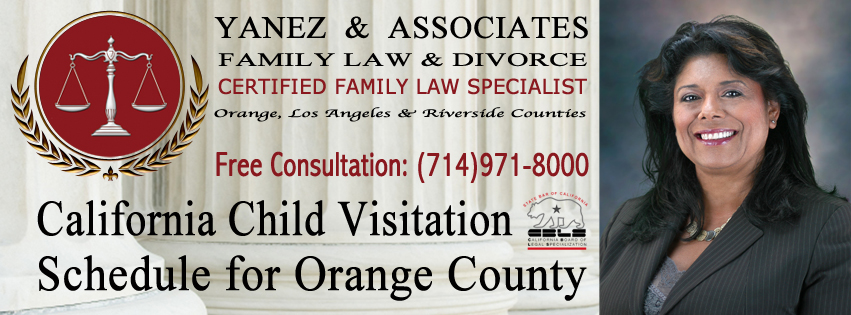Orange County California Child Visitation Schedules
Why is Visitation Necessary?
When two unmarried parents share a child in California, they usually have to get a child custody order. Child custody is divided into two categories: legal custody and physical custody. Legal custody determines who is responsible for making important decisions in the child’s life regarding things such as education, religion, mental and physical health, and extracurricular activities.
However, visitation deals with physical custody. Physical custody determines with which parent the child resides and spends most of his or her time. Physical custody can be either awarded jointly to both parents or solely awarded to one parent.
When the parents are awarded joint custody, this means that the child resides with both parents. Time may or may not be split evenly between the parents, and the amount of time spent with each parent may change as the child ages and the custody order is modified.
When one parent is awarded primary custody, or sole custody, it means that the child lives primarily with one parent, and the other parent may be awarded visitation rights.
What is Visitation?
When one parent is awarded visitation, it means that he or she can spend time with the child, but the child does not live with this parent. Because custody and visitation orders are determined based on the best interests of the child, the reasons for awarding visitation instead of custody will vary.
Visitation is common in certain situations, and custody and visitation orders can be modified if the child’s best interests change.
• A parent who has no relationship with a child for any reason will likely not be awarded custody, but visitation, to get to know the child and form a relationship. In the future, the parent may be granted partial custody.
• A parent who has substance abuse problems will likely not be awarded custody but may be allowed supervised visitation with the child.
• Parents who live far apart may not realistically be able to share custody of a child, so one parent may be awarded visitation rights instead.
Types of Visitation Orders
Depending on the type of relationship the parent has with the child, the best interests of the child, the relationship between the parents, and the schedules of the parents and the child, different types of visitation orders exist and can be customized for each family situation. In some cases, no visitation will be allowed at all.
Scheduled Visitation - Some families can benefit from a scheduled visitation that contains the days and times when the child will have visitation with the noncustodial parent. This type of visitation order can prevent conflict, avoid confusion, and be as detailed as necessary to ensure that the child spends time with both parents. Scheduled visitation orders can also be designed to include holidays and special occasions, like birthdays or vacations.
Reasonable Visitation - In some families, a strict and detailed visitation schedule is not necessary. Reasonable visitation orders allow the family to have more control over the exact schedule. In these situations, parents are usually on good terms with each other and can work out a visitation schedule with each other according to certain parameters listed in the visitation order.
Supervised Visitation - When the child’s safety and wellbeing is potentially at risk through spending time alone with one parent, a visitation order may require that visitation be supervised by the other parent, another adult, or a professional. The times, dates, person providing supervision and the location of the visits is usually specified in the visitation order. Supervised visitation is common in several situations:
• When a parent and child have little or no existing relationship due to a long absence or never having met;
• When the parent with visitation rights is trying to prove that he or she can be trusted with the child;
• When there is a history of abuse, violence or neglect, or of substance abuse on the part of parent;
• When the parent is not physically or mentally capable of caring for the child due to injury, mental illness, or another reason;
• When there is a reason to believe that the parent may abduct the child.
No Visitation - When the noncustodial parent could potentially be physically, emotionally or mentally harmful to the child, it is in the best interest of the child not to have contact with the parent. In this case, no custody or visitation is awarded.
Grandparent Visitation Rights in Orange County California
In California, the law allows grandparents to ask the court for reasonable visitation with a grandchild under certain circumstances. The grandparent must have a preexisting relationship with the grandchild, and maintaining that relationship must be in the best interest of the child. The grandparent’s right to visitation cannot interfere with the parents’ parental right to make decisions for their child.
If the parents are married to each other, the only way a grandparent can request visitation is under the following circumstances:
• The parents live separately;
• One parent is missing, and has been for at least a month;
• One parent agrees that the grandparent should have visitation rights;
• The child does not live with either parent; or
• The grandchild has been adopted by a stepparent.
If these circumstances change, a parent can request that the grandparent’s right to visitation is revoked.
Determining the Best Interest of the Child in Custody & Visitation in California
The type of visitation and the amount of time awarded depends on the best interest of the child, which is the legal standard used to resolve child-related legal issues. In California, the court uses the following criteria to determine the best interest of the child.
• The child’s age,
• The child’s health,
• The relationship between the child and each parent,
• Each parent’s ability to provide and care for the child,
• Any history of violence, abuse, neglect, or substance abuse,
• The child’s current ties to his or her community.
Your right, as a parent, to visitation cannot be taken away based on your gender, the age or gender of your children, your marital status, lifestyle, religion, sexual orientation, or a disability.
Orange County Family Law Attorney for child visitation schedules
If your family has a child custody order, visitation may be a part of that. Whether you believe it is in your best interest to have visitation rights with your child or grandchild, or you want to prevent visitation rights of another parent or grandparent, discuss your situation with a skilled family law attorney today. At Yanez & Associates, we have your child’s best interests in mind. Contact us today for a free initial consultation.
















